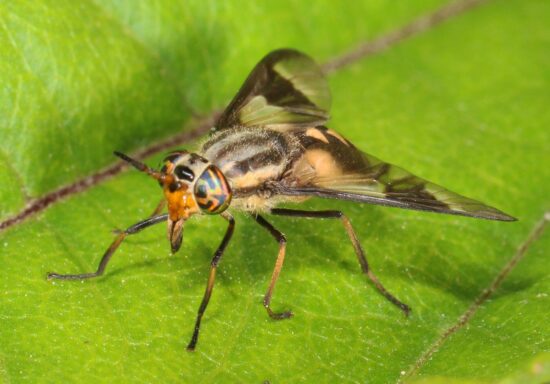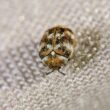If you’ve ever been attacked by deer flies during a peaceful outdoor adventure, you know exactly how brutal these little vampires can be. Unlike mosquitoes that you barely feel, deer flies pack a serious punch with their razor-sharp bites that can leave you bleeding and in real pain.
The tricky thing about finding the best deer fly repellent is that these pests are totally different from mosquitoes. While mosquitoes use their sense of smell to find you, deer flies hunt mainly with their eyes. This means many bug sprays that work great on mosquitoes won’t do much against deer flies.
But don’t worry! There are plenty of ways to fight back against these flying menaces. The secret is using multiple methods together instead of relying on just one deer fly repellent. Some focus on chemicals, others use physical barriers, and a few get creative with traps and tricks.
Here are some proven repellents that actually work against deer flies, ranked from most effective to creative alternatives.
1. DEET Based Repellents (20 to 30 Percent)
DEET might not be perfect against deer flies, but it’s still one of the most reliable options out there. University research shows that DEET can give you several hours of protection from these biting pests, even though it works better on mosquitoes.
The key is getting the right strength. Look for products with 20 to 30 percent DEET for the best balance of protection and safety. Some top choices include 3M Ultrathon, which has a controlled release formula that lasts longer, Ben’s 30% DEET, and Coleman 100 Max Insect Repellent.
When applying DEET, cover all exposed skin but avoid your eyes and mouth. The protection typically lasts 4 to 6 hours, depending on how much you sweat and the exact product you use.
The downside? DEET has a strong smell, feels greasy on your skin, and can actually melt plastic items like sunglasses. But when deer flies are swarming, these minor annoyances beat getting bitten repeatedly.
2. Picaridin Repellents Work Better on Flies
Here’s a game changer: picaridin actually works better on flies than DEET does. This synthetic compound, made from the same plants that give us black pepper, has become the go-to choice for many outdoor lovers dealing with biting flies.
Sawyer Picaridin Insect Repellent comes in both lotion and spray forms. The 20 percent lotion can protect you from mosquitoes for up to 14 hours and from biting flies for 8 hours. That’s impressive staying power.
Unlike DEET, picaridin has no smell, doesn’t feel greasy, and won’t damage your gear. You can spray it on your expensive sunglasses without worry. Products like Cutter Advanced and Natrapel also use picaridin as their main ingredient.
The only real downside is that picaridin costs more than DEET and hasn’t been around as long, so there’s less long-term safety data. But for deer fly protection, it’s often the best deer fly repellent you can buy.
3. Permethrin Treated Clothing Kills Bugs on Contact
While most repellents just keep bugs away, permethrin actually kills them when they touch your clothes. This powerful insecticide can eliminate ticks, mosquitoes, chiggers, mites, and more than 55 other types of bugs, including deer flies.
You have a few options here. Sawyer Permethrin spray lets you treat your own clothes at home. Just spray your hiking clothes, let them dry, and you’re protected for up to 6 washings. For non-washable items like tents and backpacks, the treatment lasts up to 42 days.
You can also buy pre-treated clothing from companies like Insect Shield. These clothes come ready to wear and maintain their bug-killing power for much longer than DIY treatments.
One study found that permethrin reduced deer fly problems by an amazing 95 percent. The catch? You can never apply permethrin directly to your skin. It’s clothing and gear only.
4. Deer Fly Patches Catch Them Before They Bite
Sometimes the simplest solutions work best. Deer fly patches are small, flesh-colored sticky strips that attach to the back of your hat. When deer flies come in for the attack, they get stuck to the patch instead of biting you.
TredNot Deer Fly Patches are the most popular brand, and they’ve been tested by Ohio State University and the Michigan Department of Fisheries and Wildlife. The idea is brilliant in its simplicity: deer flies target the highest part of moving objects, which is usually your head.
These patches have no chemicals, no smell, and nothing greasy to rub on your skin. Just stick them to your hat and forget about them. Many people report that they can finally enjoy hiking and fishing again after years of deer fly torture.
The only downside is that you need to remember to put them on and replace them when they get full of dead flies. But compared to getting bitten repeatedly, that’s a small price to pay.
5. Head Nets Create a Bug Free Zone
When deer flies are really bad, sometimes you need to bring out the big guns. Head nets create a physical barrier that keeps flies away from your face and neck, where they love to bite most.
The best options have black mesh because it’s easier to see through than white mesh. Sea to Summit Mosquito Head Net with Insect Shield combines physical protection with a permethrin treatment for double protection. Ben’s Invisinet Head Net is designed specifically for baseball caps, while Coghlan’s No-See-Um Head Net works with any hat style.
Always wear a hat under your head net to keep the mesh away from your skin. This gives you better airflow and prevents any determined flies from biting you through tiny holes in the netting.
Head nets can feel hot in direct sunlight, and they make drinking water or eating snacks more difficult. But when deer flies are at their worst, a head net might be your best friend.
6. Essential Oil Blends Smell Great and Repel Bugs
- Plant-based peppermint oil formula repels pests naturally
- Safe to use around pets, kids, and indoor living spaces
- Great for garages, attics, baseboards, and outdoor areas
- Fresh mint scent with long-lasting protection
If you prefer natural solutions, essential oils can help keep deer flies away. While they’re not as effective as chemical repellents, they smell much better and are safe for kids and people with sensitive skin.
The most effective oils against deer flies include eucalyptus, peppermint, citronella, lavender, tea tree, and lemongrass. Mix several oils together for better results. Eucalyptus oil is even approved by the Centers for Disease Control as an insect repellent.
You can buy pre-made blends like Wondercide’s natural repellent or make your own by mixing essential oils with a carrier like witch hazel or coconut oil.
The biggest problem with essential oils is that they evaporate quickly, so you need to reapply them every hour or two. They also don’t work as well in heavy deer fly areas where you really need serious protection.
7. Oil of Lemon Eucalyptus Provides Natural Protection
Don’t confuse this with regular lemon eucalyptus essential oil. Oil of Lemon Eucalyptus (OLE) is a processed version that’s been approved by the EPA as an effective insect repellent.
Products like Repel Plant-Based Lemon Eucalyptus and Off! Botanicals use 30 to 40 percent concentrations of OLE. This deer fly repellent can protect you for up to 6 hours, which is pretty impressive for a plant-based option.
OLE has a fresh, citrusy smell that most people find pleasant. It’s also non-greasy and won’t damage your gear like DEET can.
The protection time is shorter than DEET or picaridin, and it may not hold up as well in areas with lots of deer flies. But for mild to moderate fly problems, OLE can be a great natural choice.
8. Blue Sticky Traps Use Science to Catch Flies
Here’s where things get interesting. Researchers have found that deer flies are incredibly attracted to bright blue objects. You can use this knowledge to set up traps that actually reduce the number of flies in your area.
The setup is simple: get a bright blue container like a coffee can or flower pot, mount it on a pole, and cover it with clear Tanglefoot (a super sticky coating). The blue color attracts deer flies from surprisingly far away, and they get stuck in the goo.
University researchers report that the blue color is such a powerful attractant that people standing near the trap don’t even get bitten. The flies head straight for the blue trap instead.
This method requires some preparation and the sticky Tanglefoot can be messy to work with. But if you’re dealing with deer flies in your yard or a regular camping spot, blue traps can make a huge difference.
9. Smart Clothing Choices Block Bites
Sometimes the best deer fly repellent is simply not giving them access to your skin in the first place. Deer flies have strong, sharp mouthparts that can bite through thin fabric, but proper clothing can stop them cold.
Always wear a hat because deer flies love to attack the back of your head and will actually burrow into your hair to bite your scalp. Long sleeves and pants in light colors work better than dark clothes, which attract more flies.
For maximum protection, tuck your pants into your socks and your sleeves into gloves. This prevents flies from getting inside your clothing where they can bite unprotected skin.
The obvious downside is that full coverage can be hot and uncomfortable in warm weather. But in heavy deer fly areas, a little discomfort beats painful bites and potential infections.
10. Dryer Sheets Keep Flies Away
This might sound crazy, but many outdoor workers swear by using dryer sheets to repel deer flies. The strong, soapy scent seems to ward off both deer flies and horse flies.
Bounce dryer sheets are mentioned most often in success stories. Some people rub the sheets directly on their clothes and exposed skin, while others tuck them into their hats or pockets.
While there’s not much scientific research on this method, one study did find that Bounce dryer sheets effectively repelled fungus gnats. Plus, dryer sheets are cheap, easy to find, and safe to use.
The protection probably doesn’t last very long, and you’ll need to replace the sheets regularly. But as a backup method or emergency solution, dryer sheets are worth trying.
11. Fans and Air Movement Blow Flies Away
Deer flies are strong fliers, but they struggle in moving air. Setting up fans on your patio or deck can create a bug-free zone where you can actually relax outdoors.
Portable battery-powered fans work great for camping, while plug-in fans are perfect for backyard gatherings. Position fans to create a cross-breeze that covers your seating area.
This method works immediately, provides cooling on hot days, and uses no chemicals. The downside is that you need a power source and the protection only covers the immediate area around the fans.
If you’re dealing with deer flies in your yard, installing outdoor ceiling fans can provide long-term relief for patios and outdoor living spaces.
12. Timing and Location Make All the Difference
Understanding deer fly behavior can help you avoid them completely. These pests are most active during the hottest parts of the day, usually late morning through early afternoon.
Plan your outdoor activities for early morning or late afternoon when deer flies are less active. They also can’t travel very far from their breeding areas, so moving just 100 to 200 feet away from a swarm often solves the problem immediately.
Deer flies need wet areas to breed, so staying away from ponds, streams, and marshes during peak season reduces your encounters. If you must be near water, try to stay in areas with good wind or open spaces.
The best part about avoidance tactics is that they cost nothing and work 100 percent when you can use them. The downside is that they limit where and when you can enjoy outdoor activities.
13. Combination Methods Give Maximum Protection
The most effective approach combines multiple deer fly repellent methods for layered protection. Many experts recommend using permethrin-treated clothing plus picaridin on exposed skin for the best results.
You can safely combine different types of repellents as long as you follow the directions on each product. For example, treat your clothes with permethrin the night before your trip, then apply picaridin to your skin in the morning.
Add physical protection like a hat and light-colored clothing, and you’ve got a comprehensive defense system. Some people also carry backup methods like dryer sheets or essential oils for extra protection.
The combination approach costs more and requires planning ahead, but it provides the most reliable protection against deer flies.
14. Encourage Natural Predators for Long Term Control
If you own property where deer flies are a regular problem, encouraging their natural enemies can provide long-term relief. Birds, bats, spiders, and other bug-eating animals can significantly reduce deer fly populations over time.
Install bird houses and bat boxes to attract these natural pest controllers. Avoid using broad-spectrum pesticides that kill beneficial insects along with the pests. Plant native flowers and shrubs that support insect-eating wildlife.
This approach takes time to work and won’t give you immediate relief. But property owners who focus on natural predators often see dramatic improvements in their deer fly problems after a few seasons.
The environmental benefits make this method especially appealing for people who want to reduce their chemical use while still controlling pests.
15. Commercial Traps and Decoys Catch Large Numbers
- 4200V electric grid zaps mosquitoes, flies, moths, and gnats fast
- Covers up to ½ acre—great for patios, gardens, and camping
- Chemical-free pest control, safe around pets and kids
- Easy setup with hanging loop, removable tray, and replaceable bulb
For serious deer fly problems, commercial traps can catch impressive numbers of flies and reduce the local population. The Horse Pal trap uses a large, inflatable black ball that gets warm in the sun and attracts female flies looking for a blood meal.
When the flies can’t find blood, they try to escape upward and get funneled into a collection jar where they die. DIY versions use black trash bags with sticky coatings mounted on moving objects like lawnmowers.
Vehicle-mounted sticky traps work especially well because deer flies are attracted to large, dark, moving objects. Some people report their truck traps getting completely covered with dead flies during peak season.
These methods require setup and maintenance, and the sticky materials can be messy to handle. But they can dramatically reduce deer fly numbers in localized areas.
The Bottom Line on Deer Fly Protection
Finding the best deer fly repellent isn’t about choosing just one method. These tough little biters require a multi-layered approach that combines the most effective techniques for your specific situation.
Chemical repellents like picaridin and DEET provide your first line of defense, especially when combined with permethrin-treated clothing. Physical barriers like head nets and protective clothing work when chemical methods aren’t enough.
Remember that deer flies hunt with their eyes, not their noses, which makes them harder to repel than mosquitoes. They’re also among the fastest flying insects, so you can’t outrun them once they lock onto you.
The key is preparation. Treat your clothes with permethrin the night before outdoor activities. Apply your chosen deer fly repellent to exposed skin. Wear appropriate clothing and bring backup methods like patches or dryer sheets.
With the right combination of methods, you can finally enjoy the outdoors without turning into a deer fly buffet. These persistent pests have met their match when you fight back with science, preparation, and the proven techniques covered in this guide.




